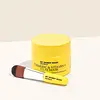What's inside
What's inside
 Key Ingredients
Key Ingredients

 Benefits
Benefits

 Concerns
Concerns

 Ingredients Side-by-side
Ingredients Side-by-side

Water
Skin ConditioningKaolin
AbrasiveGlycerin
HumectantPetrolatum
EmollientCetearyl Alcohol
EmollientPropanediol
SolventStearyl Alcohol
EmollientBentonite
AbsorbentPEG-100 Stearate
Glyceryl Stearate
EmollientButyrospermum Parkii Butter
Skin ConditioningMagnesium Aluminum Silicate
AbsorbentPyrus Malus Fruit Extract
Skin ConditioningPersea Gratissima Oil
Skin ConditioningXanthan Gum
EmulsifyingSorbitan Stearate
EmulsifyingPhenoxyethanol
PreservativeCaprylyl Glycol
EmollientCucumis Sativus Seed Oil
EmollientHexylene Glycol
EmulsifyingEthylhexylglycerin
Skin ConditioningCitric Acid
BufferingGlyceryl Acrylate/Acrylic Acid Copolymer
HumectantWater, Kaolin, Glycerin, Petrolatum, Cetearyl Alcohol, Propanediol, Stearyl Alcohol, Bentonite, PEG-100 Stearate, Glyceryl Stearate, Butyrospermum Parkii Butter, Magnesium Aluminum Silicate, Pyrus Malus Fruit Extract, Persea Gratissima Oil, Xanthan Gum, Sorbitan Stearate, Phenoxyethanol, Caprylyl Glycol, Cucumis Sativus Seed Oil, Hexylene Glycol, Ethylhexylglycerin, Citric Acid, Glyceryl Acrylate/Acrylic Acid Copolymer
Aloe Barbadensis Leaf Juice
Skin ConditioningKaolin
AbrasiveRicinus Communis Seed Oil
MaskingBetaine
HumectantCetearyl Alcohol
EmollientMacadamia Integrifolia Seed Oil
Skin ConditioningXanthan Gum
EmulsifyingCurcuma Longa Root Powder
Skin ConditioningCannabis Sativa Seed Oil
EmollientSaccharide Isomerate
HumectantCitrus Aurantium Dulcis Peel Oil
MaskingCitrus Limon Peel Oil
MaskingGlyceryl Caprylate
EmollientTocopheryl Acetate
AntioxidantPrunus Davidiana Extract
AntioxidantTerminalia Ferdinandiana Fruit Extract
AntioxidantCamellia Sinensis Leaf Extract
AntimicrobialVitis Vinifera Fruit Extract
Skin ConditioningCitric Acid
BufferingSodium Citrate
BufferingP-Anisic Acid
MaskingBenzoic Acid
MaskingAloe Barbadensis Leaf Juice, Kaolin, Ricinus Communis Seed Oil, Betaine, Cetearyl Alcohol, Macadamia Integrifolia Seed Oil, Xanthan Gum, Curcuma Longa Root Powder, Cannabis Sativa Seed Oil, Saccharide Isomerate, Citrus Aurantium Dulcis Peel Oil, Citrus Limon Peel Oil, Glyceryl Caprylate, Tocopheryl Acetate, Prunus Davidiana Extract, Terminalia Ferdinandiana Fruit Extract, Camellia Sinensis Leaf Extract, Vitis Vinifera Fruit Extract, Citric Acid, Sodium Citrate, P-Anisic Acid, Benzoic Acid
 Reviews
Reviews

Ingredients Explained
These ingredients are found in both products.
Ingredients higher up in an ingredient list are typically present in a larger amount.
Cetearyl alcohol is a mixture of two fatty alcohols: cetyl alcohol and stearyl alcohol. It is mainly used as an emulsifier. Emulsifiers help prevent the separation of oils and products. Due to its composition, it can also be used to thicken a product or help create foam.
Cetearyl alcohol is an emollient. Emollients help soothe and hydrate the skin by trapping moisture.
Studies show Cetearyl alcohol is non-toxic and non-irritating. The FDA allows products labeled "alcohol-free" to have fatty alcohols.
This ingredient is usually derived from plant oils such as palm, vegetable, or coconut oils. There is debate on whether this ingredient will cause acne.
Due to the fatty acid base, this ingredient may not be Malassezia folliculitis safe.
Learn more about Cetearyl AlcoholCitric Acid is an alpha hydroxy acid (AHA) naturally found in citrus fruits like oranges, lemons, and limes.
Like other AHAs, citric acid can exfoliate skin by breaking down the bonds that hold dead skin cells together. This helps reveal smoother and brighter skin underneath.
However, this exfoliating effect only happens at high concentrations (20%) which can be hard to find in cosmetic products.
Due to this, citric acid is usually included in small amounts as a pH adjuster. This helps keep products slightly more acidic and compatible with skin's natural pH.
In skincare formulas, citric acid can:
While it can provide some skin benefits, research shows lactic acid and glycolic acid are generally more effective and less irritating exfoliants.
Most citric acid used in skincare today is made by fermenting sugars (usually from molasses). This synthetic version is identical to the natural citrus form but easier to stabilize and use in formulations.
Read more about some other popular AHA's here:
Learn more about Citric AcidKaolin is a clay. It is used for oil control and to help minimize pores. Like other clays, kaolin has the ability to absorb excess sebum or oil. This can help clean out pores and mattify the skin.
Some types of kaolin may have exfoliating properties. When water is added to kaolin, it becomes a paste with small abrasive particles.
Most kaolin is a white color, but may be pink/orange/red depending on where it comes from.
The name 'kaolin' comes from a Chinese village named 'Gaoling'. Kaolin clay comes from rocks rich in kaolinite. Kaolinite, the mineral, has a silicate layered structure. Kaolinite is formed from chemical weathering of aluminum siilicate minerals.
Besides skincare, kaolin is commonly used to make glossy paper, in ceramics, toothpaste, and as medicine to soothe stomach issues.
Learn more about KaolinXanthan gum is used as a stabilizer and thickener within cosmetic products. It helps give products a sticky, thick feeling - preventing them from being too runny.
On the technical side of things, xanthan gum is a polysaccharide - a combination consisting of multiple sugar molecules bonded together.
Xanthan gum is a pretty common and great ingredient. It is a natural, non-toxic, non-irritating ingredient that is also commonly used in food products.
Learn more about Xanthan Gum